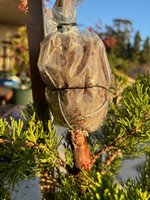zeejet
Mame
I recently came across a good deal on a Juniper chinensis 'Torulosa' at a small local nursery. It's about 7' tall and 1.2" thick near the base. It's currently in a 5 gallon nursery container with nursery soil mix. Only 40USD.
The movement is subtle toward the base so I think this might make a decent practice run at an informal upright. I would like it to grow a bit thicker, but at it's current height, it's a bit unwieldy when it comes time next season to repot and do root work. However, I feel like it would be a waste of material to chop this down and not salvage some of it through airlayers.
I was initially hoping to take airlayers of the trunk twice - first on the top third section (April-May) and then again for the middle third section (June-July). This of course assumes it will take about 2 months to develop enough roots. I know airlayers are safer to perform on the branches rather than the main trunk but I figured I would ask here and see if there are any insights.
I would be attempting the standard ring method and using either sphagnum moss in a bag tied around the ring or an outfitted nursery pot with a moisture-retentive but still relatively well-draining bonsai mix (equal parts pumice, lava rock, fir bark, and potting mix).
Additionally, the tree was planted well above it's base and there is very little taper towards the base. I'm also considering ground layering this to grow a new nebari.
I would appreciate any feedback regarding this idea or any key tips for airlayering.
The movement is subtle toward the base so I think this might make a decent practice run at an informal upright. I would like it to grow a bit thicker, but at it's current height, it's a bit unwieldy when it comes time next season to repot and do root work. However, I feel like it would be a waste of material to chop this down and not salvage some of it through airlayers.
I was initially hoping to take airlayers of the trunk twice - first on the top third section (April-May) and then again for the middle third section (June-July). This of course assumes it will take about 2 months to develop enough roots. I know airlayers are safer to perform on the branches rather than the main trunk but I figured I would ask here and see if there are any insights.
I would be attempting the standard ring method and using either sphagnum moss in a bag tied around the ring or an outfitted nursery pot with a moisture-retentive but still relatively well-draining bonsai mix (equal parts pumice, lava rock, fir bark, and potting mix).
Additionally, the tree was planted well above it's base and there is very little taper towards the base. I'm also considering ground layering this to grow a new nebari.
I would appreciate any feedback regarding this idea or any key tips for airlayering.






